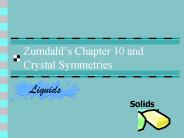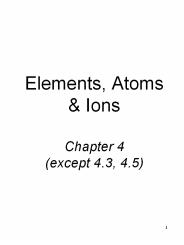Zumdahls PowerPoint PPT Presentations
All Time
Recommended
... Groups and hundreds of 2D wallpaper arrangments, there are only SEVEN 3D ... Those separations, d, comparable to , the wavelength of incident radiation, ...
| PowerPoint PPT presentation | free to download
Partial Pressures and Mole Fractions, Xi. Effusion. Diffusion. Our Atmosphere ... has average thermal energy of kT per molecular motion or RT for a mole of them. ...
| PowerPoint PPT presentation | free to download
Trends in the Periodic Table trend: direction or pattern p. 70-75
| PowerPoint PPT presentation | free to view
A solution is a homogeneous mixture that may be a solid, liquid, or gas. What factors affect the rate of dissolving for a solution? Stirring (agitation)
| PowerPoint PPT presentation | free to download
Title: Electrolysis Subject: Chemistry 2:17/25 (5 s) Author: Jeff Christopherson Keywords: electrolysis Description: Unit 2: Matter and Energy
| PowerPoint PPT presentation | free to download
Title: Electrochemistry Subject: Chemistry Author: Jeff Christopherson Description: Unit14 Last modified by: jwohlfarth Created Date: 12/23/2001 7:57:19 PM
| PowerPoint PPT presentation | free to view
Atoms, Molecules and Ions Chapter 2 HI hydrogen iodide NF3 nitrogen trifluoride SO2 sulfur dioxide N2Cl4 dinitrogen tetrachloride NO2 nitrogen dioxide N2O dinitrogen ...
| PowerPoint PPT presentation | free to download
MATTER AND CHANGE Chemistry: The study of matter and the changes it undergoes. Matter Anything that has mass and takes up space Alchemical view of matter Matter Atoms ...
| PowerPoint PPT presentation | free to download
The energy that must be removed in order to convert one mole of liquid to solid at its freezing point. ... Mass of ice Molar Mass of ... Determination of ...
| PowerPoint PPT presentation | free to download
Unit 3 Modern Atomic Theory & the Periodic Table The Periodic Table I. History The END of Unit 3! I II III * About 70 elements had been discovered by the mid 1800 ...
| PowerPoint PPT presentation | free to download
Chemical Reactions and Solution Stoichiometry Chapter Contents Water Aqueous Solutions Electrolytes Strong and Weak ... water-ion interactions ...
| PowerPoint PPT presentation | free to download
Spontaneity, Entropy, Free Energy, and Why All Things Happen The Universe Becomes Less Predictable ZUMDAHL S CHAPTER 16
| PowerPoint PPT presentation | free to download
Zumdahl s Chapter 3 Stoichiometry Chapter Contents Aston s Atomic Mass The Mole Molar Mass % Composition Molecular Formulae Chemical Equations Balancing Chemical ...
| PowerPoint PPT presentation | free to download
Title: Electrolysis Subject: Chemistry 2:17/25 (5 s) Author: Jeff Christopherson Keywords: electrolysis Description: Unit 2: Matter and Energy
| PowerPoint PPT presentation | free to view
CHEMICAL BONDING Set 6 Cocaine SAVE PAPER AND INK!!! When you print out the notes on PowerPoint, print
| PowerPoint PPT presentation | free to view
Temperature v. Heat * Anders Celsius (1701 - 1744) Lord Kelvin (William Thomson) 1824 - 1907 Daniel Gabriel Fahrenheit (1686-1736) Daniel Gabriel Fahrenheit (1686 ...
| PowerPoint PPT presentation | free to download
Title: Distillation Subject: Chemistry 2:15/25 (14 s) Author: Jeff Christopherson Keywords: distillation Description: Unit 2: Matter and Energy
| PowerPoint PPT presentation | free to download
Chemistry is not a spectator sport, you must become involved, and that ... How to Solve Chemistry Problems. 1) Problem: States all of the information needed to solve ...
| PowerPoint PPT presentation | free to download
Intermolecular forces are forces between molecules. ... 41 kJ to vaporize 1 mole of water (inter) 930 kJ to break all O-H bonds in 1 mole of water (intra) ...
| PowerPoint PPT presentation | free to download
Types of Chemical Bonding. 1. Metal with nonmetal: electron transfer and ionic bonding ... Q- is the charge on the anion. r is the distance between the ions ...
| PowerPoint PPT presentation | free to download
trigonal bipyramidal. octahedral. Cl. Cl. Be. BF3. CH4. PCl5 ... trigonal pyramidal. 9. Class # of atoms. bonded to central atom # lone. pairs on central atom ...
| PowerPoint PPT presentation | free to download
Title: Lecure 8: The Second and Third Laws of Thermodynamics Author: Philip Reid Last modified by: UW Chemistry Created Date: 11/20/2002 7:37:59 PM
| PowerPoint PPT presentation | free to view
nuclear chemistry the study of nuclear reactions fission and fusion nuclear chemistry the study of nuclear reactions fission and fusion changing the mass to grams: 0 ...
| PowerPoint PPT presentation | free to download
Title: Introductory Chemistry: A Foundation FOURTH EDITION by Steven S. Zumdahl University of Illinois Author: Richard Principe (revised by) Last modified by
| PowerPoint PPT presentation | free to download
Lecture 5: Standard Enthalpies Reading: Zumdahl 9.6 Outline: What is a standard enthalpy? Defining standard states. Using standard enthalpies to determine DH rxn
| PowerPoint PPT presentation | free to view
Coordination Chemistry. A basic introduction with a critical application! Coordination Compound ... of your classmates who have taken chemistry at ANY level. ...
| PowerPoint PPT presentation | free to view
CHEMICAL BONDING Set 2 Cocaine SAVE PAPER AND INK!!! When you print out the notes on PowerPoint, print
| PowerPoint PPT presentation | free to view
Title: Intermolecular Forces Author: Rose Tree Media Last modified by: Rose Tree Media Created Date: 1/12/2005 3:23:04 PM Document presentation format
| PowerPoint PPT presentation | free to view
... Electroplating applying a thin layer of an expensive ... pump or battery or any DC source ... Ion sandwich in alphabetical order Anode ...
| PowerPoint PPT presentation | free to download
Chapter 10 Gases Teacher Note The solutions to many of the calculations are worked out in a packet in the folder for Chapter 10. Barometers and Standard Atmospheric ...
| PowerPoint PPT presentation | free to download
react the two bases with a chemical and observe the rate of the reaction ... Tables tend to list strong acids towards the top, and strong bases towards the bottom ...
| PowerPoint PPT presentation | free to view
Strong electrolytes dissociate 100%. Sum of previous two steps ... Does HF dissociate 100%? 0. If there was a strong electrolyte, ...
| PowerPoint PPT presentation | free to view
... Ion sandwich in alphabetical order Anode metal | anode ion | ... Electroplating applying a thin layer of ... you attach a variable-external-power source ...
| PowerPoint PPT presentation | free to view
Hydrogen Fuel Cells David Lorse ESS 315 What is a hydrogen fuel cell? Hydrogen fuel cells (HFCs) are a type of electrochemical cell. HFCs generate electricity by ...
| PowerPoint PPT presentation | free to download
Title: Introductory Chemistry: A Foundation FOURTH EDITION by Steven S. Zumdahl University of Illinois Author: Richard Principe Last modified by
| PowerPoint PPT presentation | free to download
3.1 The periodic table 3.1.1 Describe the arrangement of elements in the periodic table in order of increasing atomic number 3.1.2 Distinguish ...
| PowerPoint PPT presentation | free to download
... solution of sodium sulfate with a solution of barium nitrate, ... Sulfuric acid, H2SO4 Barium hydroxide, Ba(OH)2. Perchloric ... c) barium hydroxide(aq) and ...
| PowerPoint PPT presentation | free to download
while the energy of the surroundings decreases. ... Kotz, Purcell, Chemistry & Chemical Reactivity 1991, page 207. System. H2O(s) heat H2O(l) ...
| PowerPoint PPT presentation | free to view
Chapter 7 States of Matter and Changes of State * * * * * * * * * * * * * * * * * * * * * * * * * * * * * * * * * * * * * * * * * * * * * * * * * * * * * * * * A ...
| PowerPoint PPT presentation | free to view
How to Measure Pressure. Aneroid Barometer ... Lyophilization freeze drying. AIR. PRESSURE. 15psi. VAPOR. PRESSURE. 15 psi. liquid. gas ...
| PowerPoint PPT presentation | free to view
Courtesy Christy Johannesson www.nisd.net/communicationsarts/pages/chem ... alizarin yellow R (20.00 mL of 0.500 M HCl by 0.500 M NaOH) ...
| PowerPoint PPT presentation | free to view
intensive or extensive properties? Are taste and smell. intensive or extensive properties? ... elements have different properties. mass, size, reactivity, etc. ...
| PowerPoint PPT presentation | free to view
Map of the world where red represents countries which do not use the metric system ... Luminous intensity candela cd. Quantity Name Symbol ...
| PowerPoint PPT presentation | free to view
Chapter 9 Covalent Bonding: Orbitals Zumdahl & Zumdahl M. Todd Tippetts, Ph.D. * Chem FAQ: Use hybridization to describe molecular geometries. Use VSEPR theory to ...
| PowerPoint PPT presentation | free to view
Development of Periodic Table. Law of Triads. Law of Octaves ... Invented periodic table independently of Mendeleev ... Modern Periodic Table. Henry G.J. Moseley ...
| PowerPoint PPT presentation | free to view
Periodic Table. Kelter, Carr, Scott, Chemistry A World of Choices 1999, page 74 ... Two liquids on the periodic table: Mercury (Hg) is a metal and Bromine (Br) is a ...
| PowerPoint PPT presentation | free to view
The connection between weight (W) and entropy (S) is given by Boltzmann's Formula: ... Reaction in which a substance goes from one phase of state to another. ...
| PowerPoint PPT presentation | free to view
Polarity of Solvents Background Information for Soap Lab A Hydrocarbon Typical petroleum product Non-polar Oil and Water Don t Mix Oil is nonpolar Water is polar ...
| PowerPoint PPT presentation | free to view
Office Hours SMW 11:00AM 1:30PM. Office # 4-134. Telephone # 3565 ... or recombining elements), such as electrolysis, heating, and photolysis. ...
| PowerPoint PPT presentation | free to view
Divide the moles of each reactant by its stoichiometric coefficient and then compare them ... Step 2. Divide moles by its stoichiometric coefficient ...
| PowerPoint PPT presentation | free to view
This lecture concludes the topic of gas laws by ... Manometer. mercury. Patm = 740. mm Hg. 15.0 cm. 10.0 cm. What is the pressure. of the gas in the bulb? ...
| PowerPoint PPT presentation | free to view
Chapter 4. ATOMIC STRUCTURE AND THE PERIODIC TABLE. Chapter 5. ... Photoelectric Effect ... Photoelectric Effect. Quantum Mechanics. Quantum theory ...
| PowerPoint PPT presentation | free to view
A chemical bond is a strong attracting force between atoms or ions in a compound. ... http://207.10.97.102/chemzone/lessons/03bonding/dissociate.htm ...
| PowerPoint PPT presentation | free to download
We use this scale to measure the strength of an acid or base. pH is defined as the log[H ... to all aqueous solutions - acids, bases, salts, and non ...
| PowerPoint PPT presentation | free to view
2. Def - changes from one form to another, but remains the same substance. 3. No new forms of different kinds of matter formed. 4. No new chemical properties ...
| PowerPoint PPT presentation | free to view
Automobile catalytic converter. contains Pt, Pd, Rh, CuO and/or Cr2O3 ... dependence (kelvin) Rewrite the Arrhenius equation in straight line form. ...
| PowerPoint PPT presentation | free to view
























































